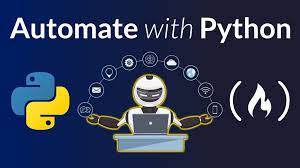Humans don’t really like performing repetitive tasks. To an extent we find them soothing and relaxing. But in general, we tend to find them tedious and boring. We like to be challenged and rewarded, to do complex things that make us grow and develop our skill sets. We don’t like to plug the same numbers over and over again into a spreadsheet, generally speaking.
This is one of the best examples of a beneficial symbiotic relationship between humans and computers. Using a programming language like Python, we can automate the performance of repetitive tasks in an efficient and effective way.

What is Python Automation?
To start approaching automation with Python, you’ll have to understand two things first: what automation is, and what Python is. You might have some idea of what these names refer to, but it’s always good to brush up your knowledge with a more precise definition.
Automation: a process in which a manually performed action is transformed into one that happens automatically.
The process of automating a task is one in which a framework is activated. This framework, for our purposes a programming script, makes it possible for the task to be performed autonomously, on its own, without user intervention.
Why would someone choose to automate a task? There are two main reasons.
- Automating a task means that it can run a lot quicker, most of the time.
- Automating a task means there’s less potential for mistakes, as the impact of human error is mitigated.
Python Automation Ideas
There are a huge range of tasks that you might opt to automate by writing Python scripts. Python users can use their creativity to create innovative automated solutions for the boring stuff they encounter in their daily life.
To give you an idea of the breadth of how users utilize Python to automate tasks, here are some common ways that Python automation is used:
Sending out, replying to, and sorting emails
Python uses Simple Mail Transfer Protocol (SMTP) which is the communication protocol used by all email systems. Python’s library provides the smptlib module built-in so there’s no need for installation. Once connected to a mail server, you can specify the sender and receiver of the email, and input all the email text.
Filling out PDFs and Excel files
Form fields can be easily filled using the pdfrw library which can read and write PDF files. Once the PDF template is connected, you can grab the keys for each form field in the PDF and assign values to each key to automatically fill out online forms.
Sending HTTP requests
There are many Python libraries used to make HTTP requests. Requests is one of the most popular and user-friendly libraries. From the requests library, you can use GET and POST Python scripts to request and send data to and from a server.
Converting image files
The pillow module allows users to import images using the Python Image Library (PIL). The save() method can be used along with a specified format to save an uploaded image in the format of your choice.
Performing quick math equations
Python can be used to define equations using SymPy and math variables. Unlike expressions, which are just a collection of symbols and operators, equations have equality. Essentially, the expression used in the code will be equal to something else, which allows for more complex math equations.
Calculating exchange rates
Python can provide direct currency exchange rates using the forex-python module. The module includes functions and parameters that can be used to input the currency for exchange. Once the currency exchange values are imported, the module will output the real-time currency exchange value.
Scraping data from web pages and saving it in the harddrive
Python features many modules that can effectively scrape data from web pages. One example is the BeautifulSoup library, which can extract data from HTML and XML files. You can specify the data you would like extracted from a web page depending on your use cases. Common use cases of web scraping include comparing prices between products, collecting email addresses, and collecting job listings.
Python code can be used to automate a whole ton more. Think of the tasks you perform dozens of times a day: copy and pasting things from one document to another, multiplying numbers by 100, or whatever else. These tasks can be automated by Python; you just have to figure out what tools you’ll need, and how you can write and run Python scripts.

